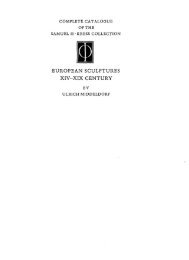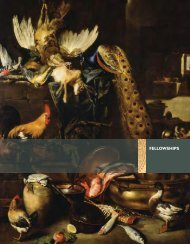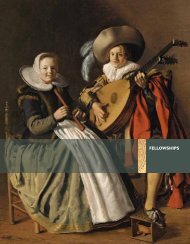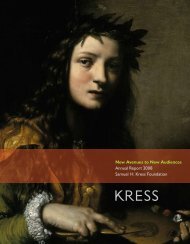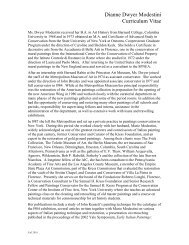The Campus Art Museum - Samuel H. Kress Foundation
The Campus Art Museum - Samuel H. Kress Foundation
The Campus Art Museum - Samuel H. Kress Foundation
Create successful ePaper yourself
Turn your PDF publications into a flip-book with our unique Google optimized e-Paper software.
Effects and Influences of the Great <strong>Kress</strong><br />
“Giveaway”<br />
“Never in the history of<br />
art collecting has so<br />
much been owed by<br />
so many to so few.”<br />
Burlington Magazine editorial<br />
Climbing stairs to the second floor of the campus art museum, I followed a group<br />
of high school students, a parent chaperon, and museum docent into the large<br />
rectangular room filled mostly with Renaissance and Baroque art from the <strong>Kress</strong><br />
Collection. I was curious how these teenagers from a small rural town about fortyfive<br />
minutes away would interact with religious and mythological works created<br />
centuries earlier. A skinny young man in black jeans and cowboy hat lagged<br />
behind. Two girls giggled, engaged in their own conversation. <strong>The</strong> docent was a<br />
middle-aged man and had obviously done tours with high school students before.<br />
He staked out a place before a painting, waited until most had gathered, gazed<br />
up at the work and asked, “What do you see?” “Half-naked people,” replied a boy.<br />
His classmates laughed. “Yes,” responded the docent. “What else?” “Angels,” said<br />
someone. “Fire” replied someone else. Soon all were looking intently at the painting,<br />
trying to name something that hadn’t yet been mentioned. After they had listed<br />
a number of items, the docent asked, “What has the artist done to portray heaven<br />
and hell?” <strong>The</strong> students had no problem in answering, pointing out things like the<br />
angels in heaven and contorted faces of pain in hell. He asked about associated<br />
colors and directions (heaven was up; hell, down), then commented on how skilled<br />
the students were at “reading” the painting and how they were reading it in much<br />
the same way as people 500 years before had done, how we continue to use many of<br />
the same images today to mean much the same things as they had meant so long ago.<br />
<strong>The</strong> docent shifted the group to a painting of Venus and Adonis. He told well<br />
the love story involving a goddess and a mortal, courtship and death. <strong>The</strong> students’<br />
attention captured, he went on to talk about how Christianity changed views of<br />
the mythological world and, in the process, introduced the students to how art can<br />
reflect society, its beliefs and values.<br />
We moved on to a Madonna and Child painting. <strong>The</strong> docent began with his<br />
usual question, “What’s going on here?” <strong>The</strong> students, perhaps hoping for another<br />
love story, were paying attention but didn’t have much to offer in response: “A<br />
woman holding a child.” “<strong>The</strong> Virgin Mary and Jesus.” “Why,” asked the docent,<br />
“does the baby Jesus in this picture look so buff?” Someone guessed, “because<br />
babies are chubby.” <strong>The</strong> docent laughed and said, “Well, probably more because the<br />
artists at this time were influenced by Michelangelo and he made everyone look<br />
buff.” He talked more about Michelangelo and the impact of master artists and then<br />
commented, “We get to see these paintings, but through them we get to look back<br />
in time and see how people thought.”<br />
As the group was shepherded into another gallery, I asked a docent whether,<br />
from her experience, teenagers usually got as engaged with the art as this group<br />
had. She replied that doing tours with children and teens was usually easier than<br />
with adults because adults feared they would say something “wrong.” She stated<br />
that the docents generally liked working with the Renaissance and Baroque Gallery<br />
Effects and Influences of the Great <strong>Kress</strong> “Giveaway”<br />
4



